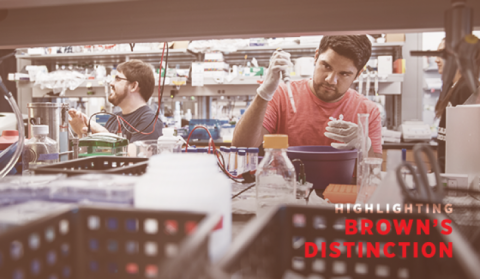Highlighting Brown's distinction in brain science

Brain scientists at Brown have bold aspirations. Those aspirations may change our fundamental understanding of the human brain and also transform what’s possible for treating brain-related disorders and diseases.
“Sometimes in the intensive care unit, I meet people who just yesterday had a brain stem stroke or a spinal cord injury,” said Dr. Leigh Hochberg, professor of engineering at Brown, a critical care neurologist at Massachusetts General Hospital and director of the BrainGate brain-computer interface research team. “When that happens in the future, I want to be able to say to them: ‘We’re going to be able to restore your ability to move and your ability to communicate. And we’ll be able to do that tomorrow.’”
In Providence and across the world, neurologists, neuroscientists, engineers, computer scientists, mathematicians, psychologists and other researchers across the University are making a profoundly positive impact on the human condition.
And with vexing neurodegenerative diseases including ALS and Alzheimer’s affecting an aging population, and traumatic brain injuries erasing the ability to move or to speak, Brown’s impact will make a difference in the lives of millions. Brown University is gaining recognition for having some of the best scientists in the world to confront brain disorders.
“I really think that this is the moment we’ll look back on,” said Diane Lipscombe, a Brown professor of neuroscience who is also president of the international Society for Neuroscience. “The time is now. There is no time to wait. We have to make discoveries, and we have to understand some of the biggest challenges, and the biggest medical problems facing society today.”
Lipscombe directs Brown’s Carney Institute for Brain Science, a nexus of research across the University that is accelerating the pace of scientific discovery about the brain and helping to find cures for some of the world’s most devastating diseases. In April 2018, a $100 million gift from Brown alumnus Robert J. Carney and Nancy D. Carney changed the former Brown Institute for Brain Science’s name and established it as one of the best-endowed university brain institutes in the country. With up to 45 labs across campus engaged in research at any given time — and more than 130 affiliated professors in departments ranging from neurology and neurosurgery to engineering and computer science — the Carney Institute is establishing Brown’s pre-eminence for the study of the brain.
Since 2011, the institute’s core faculty members have led projects with more than $116 million in grant funding. It’s no accident that one quarter of all Brown undergraduates take Introduction to Neuroscience, reflecting the excitement in the field. Well-known strengths at Brown include solving the mysteries of the brain by innovating methods to locate, decipher and fix circuits in the nervous system. The University is also recognized for devising treatments and technologies to address neurological disease and injury.
Lipscombe said one of Brown’s strengths is its breadth of expertise to study the brain at all necessary scales —from genes to circuits to healthy behavior and psychiatric disorder. Equally important, the University’s researchers contribute the deep expertise at each of those scales required to produce insights and tools to see, map, understand and even fix problems in the nervous system.
“If you want to solve some of the big questions in brain science, the Carney Institute is the place to be,” she said. “By building on our strong foundation, our faculty, scientists and students are integrating knowledge from across the disciplines to develop treatments and technologies for improved quality of life.”



